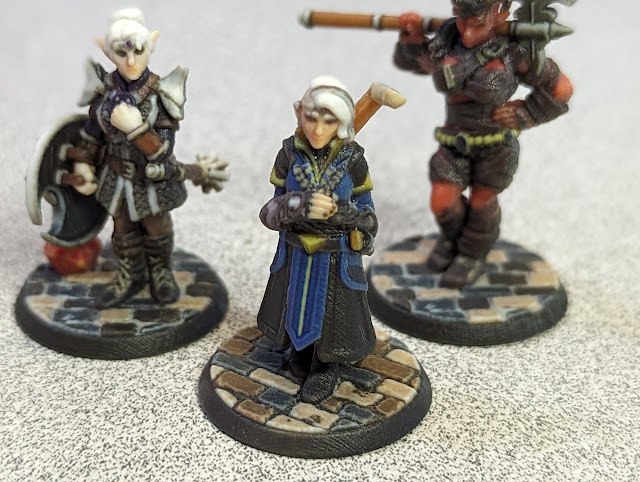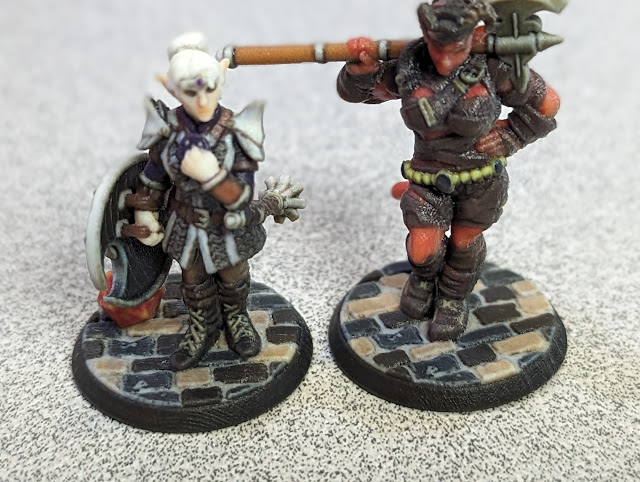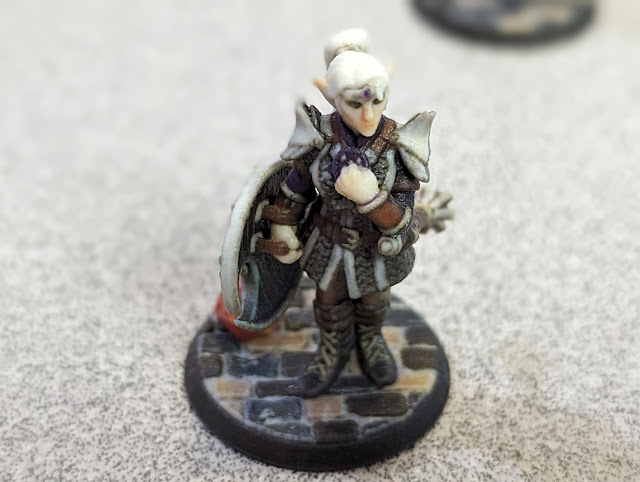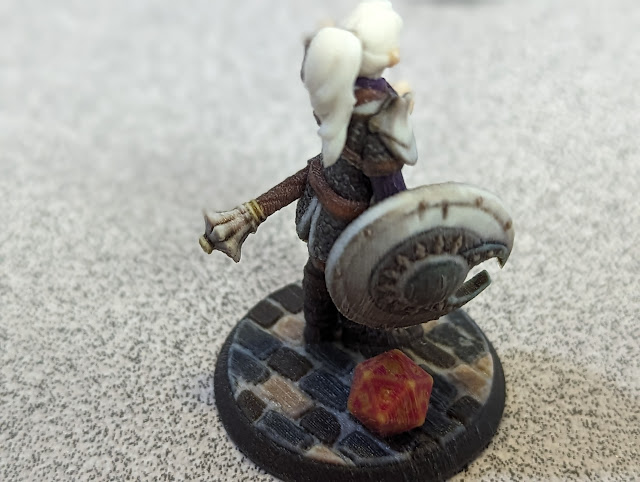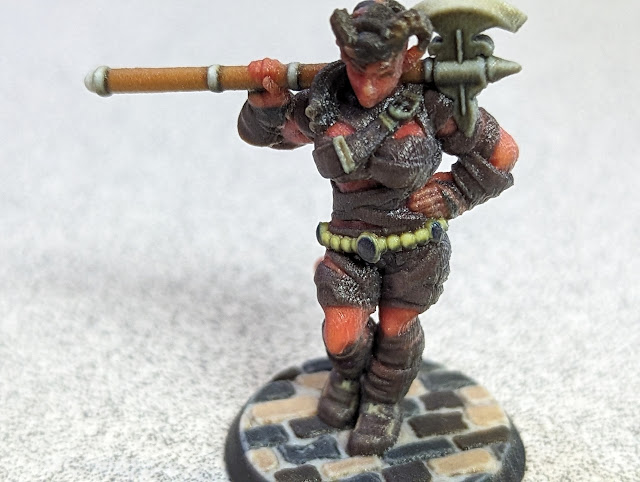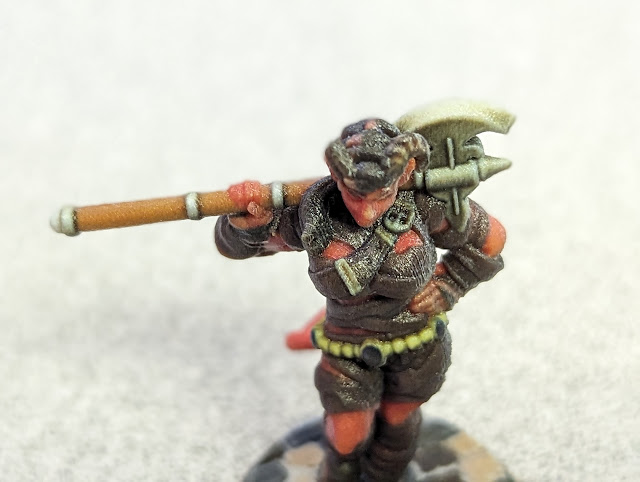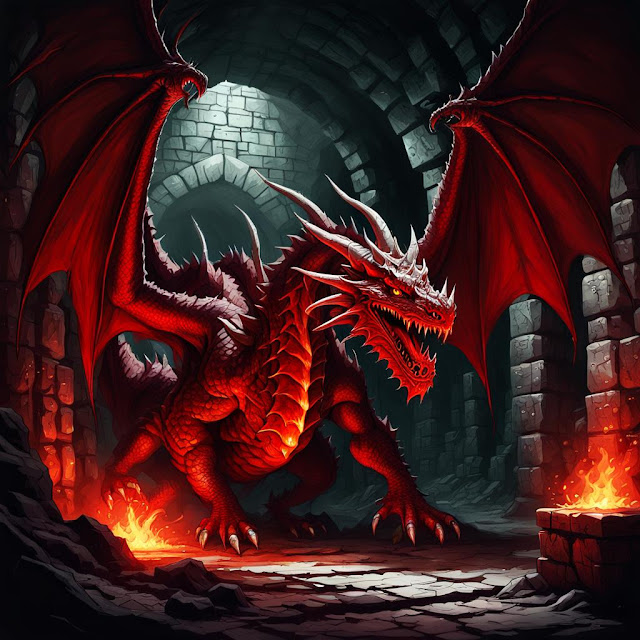1974 is an important year for the gaming hobby. It is the year that Dungeons & Dragons was introduced, the original RPG from which all other RPGs would ultimately be derived and the original RPG from which so many computer games would draw for their inspiration. It is fitting that the current owner of the game, Wizards of the Coast, released the new version, Dungeons & Dragons, Fifth Edition, in the year of the game’s fortieth anniversary. To celebrate this, Reviews from R’lyeh will be running a series of reviews from the hobby’s anniversary years, thus there will be reviews from 1974, from 1984, from 1994, and from 2004—the thirtieth, twentieth, and tenth anniversaries of the titles. These will be retrospectives, in each case an opportunity to re-appraise interesting titles and true classics decades on from the year of their original release.
—oOo—

It is over a thousand years since the founding of the Empire of Thera with the establishment of the Eternal Library by the Elves to study and decipher the
Books of Harrow. These volumes revealed that as the magic rose in the world, it enabled unimaginable horrors—previously only seen by wizards entering Astral Space—to break into the world and spread chaos, death, and destruction. Magic was yet to peak, and as the Theran Empire spread its influence and conquered new territories in search of more
Books of Harrow, it traded—even warred—for orichalcum, the magically rich metal that would further the research of the Eternal Library, and it preached of the dangers to come. Ultimately, the staff at the Eternal Library determined that the only way for people to protect themselves was to magically seal whole communities in kaers and citadels, there to wait out the centuries until after magic had peaked and begun to decrease. Centuries passed before the Scourge of the Horrors ended and the inhabitants of the kaers knew it was safe to leave, but the land their ancestors had known is changed. Horrors still exist, in dark corners and the kaers whose defences they managed to breach, and there are still kaers that remain sealed, the fate of their inhabitants unknown. In Barsaive, a former province of the Theran Empire, the Dwarf kingdom of Throal arose as the Theran Empire retreated and has already driven back an initial attempt to reclaim the province by the empire. The many peoples of Barsaive, declared by the Kingdom of Throal free from being slaves of the Theran Empire as their ancestors had been, are thriving and there are many, known as ‘Adepts’ for their magical connection to the world, who aid the kingdom and explore its new lands.
This is the setting for
Earthdawn, a new roleplaying game published by FASA in 1993. It was a big fantasy roleplaying game published at a time when no other fantasy roleplaying games were being published—except for
Advanced Dungeons & Dragons, Second Edition. At the time it looked like an aberration, because after all, if you had
Advanced Dungeons & Dragons, Second Edition, did you actually need another fantasy roleplaying game? After all, what did
Earthdawn offer that
Advanced Dungeons & Dragons, Second Edition did? The answer to that is both plenty and not a lot. Plenty, because it offered a detailed setting from the start, that of Barsaive; it provided a reason to explore the underground locations of its setting, the kaers, in way that the dungeons of
Advanced Dungeons & Dragons, Second Edition did not; it offered plenty for the Player Characters to do, such as exploring kaers, sealed and unsealed, exploring the new world, protecting others from the remaining Horrors, and so on; it offered lots of character archetypes that enabled the Player Characters to do exciting things; and it had a rules system that was coherent and consistent from start to finish. Not a lot because it was still high fantasy like that of
Advanced Dungeons & Dragons, Second Edition and you are still playing Elves, Dwarves, and the like; and kaers are still dungeons even if they are called kaers.
A Player Character or Adept in
Earthdawn is defined by his Race, Attributes, Discipline and Circle, Talents, skills, and spells. There are eight core Races, known as the ‘Name-giver’ races, detailed in the Earthdawn core book: Dwarf, Elf, Human, Ork, and Troll are similar to their depiction in other fantasy roleplaying games, but in Barsaive, Dwarves are the dominant Race and culture. The other three are Obsidiman, creatures of living rock, over seven feet tall and weighing hundreds of pounds; T’Skrang, reptilian humanoids, matriarchal, flamboyant and sometimes frivolous; and Windlings, eighteen-inch tall fairie-like creatures with dragonfly-like wings. Obsidiman are seen as slow, but dependable; Orks as nomads, whose tribes will raid the civilised lands; Trolls as feared sky raiders, aerial pirates who crew longship-like sky boats; and T’Skrang as river traders when they are not part of the river pirate federations. Each Race has its own innate abilities. For example, Obsidiman are stronger and tougher, T’Skrang have a tail attack, Trolls are stronger and tougher and have heat vision, and Windlings are not as tough, but possess Astral Sensitive Sight and Flight. Humans have the Versatility Talent, which enables them to learn Talents from Disciplines other than their own. The six Attributes are Dexterity, Strength, Toughness, Perception, Willpower, and Charisma, and they range in value between two and eighteen.
There are thirteen Disciplines in
Earthdawn. A Discipline is a way of studying magic and connecting to the magic of the world, and is both a profession and a way of life. They are Archer, Beastmaster, Cavalryman, Elementalist, Illusionist, Nethermancer, Sky Raider, Swordmaster, Thief, Troubadour, Warrior, Weaponsmith, and Wizard. The Elementalist, the Illusionist, the Nethermancer, and the Wizard are the specific spellcasters, with the Nethermancer’s magic involving the other planes. Each Discipline has eight Circles, representing the overall skill and experience of the Adept. In effect, Discipline is the equivalent of Class and Circle the equivalent of level, making
Earthdawn as much as a Class and Level roleplaying game as it is a Discipline and Circle roleplaying game.
One of the features of
Earthdawn is that both Races and Disciplines are strongly presented in the roleplaying game’s artwork. A colour section depicts all eight Races and each of the eight Discipline listings is accompanied by a ready-to-play archetype of that Discipline. Thus, the Beastmaster is accompanied by an Ork Beastmaster, the Sky Raider by the Troll Sky Raider, the Swordmaster by a T’Skrang Swordmaster, and the Weaponsmith by the Dwarf Weaponsmith. This is typical of roleplaying games designed in the nineties, but very much helped to enforce the feel and look of the world of Earthdawn.
To create an Adept in Earthdawn, a player selects a Race, Discipline, generates Attributes—either randomly or by a point-buy method, determines Step Number and Action Dice for each Attribute, assigns Ranks to the Talents from his first Circle, and assigns Ranks to Knowledge Skills, an Artisan Skills, and Language Skills. Knowledge Skills are areas of study, whilst Artisan Skills represent the arts and craft skills that the people of Barsaive practice in order to prove their creativity and thus not corrupted by the Horrors. Lastly, after equipping his Adept, a player selects one or two personality traits—one of which can be hidden if two are selected, and decides upon some background details.
Name: SheerRace: WindlingDiscipline: Archer Circle: First
ATTRIBUTE – STEP – ACTION DIEDexterity (17): 7/1D12Strength (11): 5/1D8Toughness (12): 5/1D8Perception (15): 6/1D10Willpower (15): 6/1D10Charisma (16): 7/1D12
TALENTSAvoid Blow (2): 9/1D8+1D6Direction Arrow (1): 8/2D6Karma Ritual (1): 8/2D6Missile Weapons (2): 9/1D8+1D6Mystic Aim (1): 8/2D6True Shot (1): 8/2D6
MOVEMENTFull: 48 (Land)/90 (Flight)Combat: 24 (Land)/45 (Flight)
SKILLSArtisan/Fletching (1): 8/2D6Knowledge/Windling Lore (1): 8/2D6Knowledge/Heroes & Legends (1): 8/2D6
LANGUAGESLanguage/Windling (1): 8/2D6Language/Dwarven (1): 8/2D6Read/Write/Dwarven (1): 8/2D6
KARMADice: D10 Points: 15
COMBATPhysical Defence: 10 Spell Defence: 8 Social Defence: 9 Armour: 4 Mystic Armour: 2
DAMAGEDeath Rating: 34 Wound Threshold: 9
Mechanically,
Earthdawn uses all of the standard polyhedral dice and to succeed at an action, must roll high to beat a Difficulty Number. Every Attribute, Skill, and Talent has a Step Number. The base Step Numbers for an Adept are derived directly from the Attributes and the ranks that an Adept has in his Skills and Talents will increase their Step Number. The Step Number determines the Action Die or Action Dice that the player will roll for his Adept when using a Skill or Talent. Each Step Number is equal to the average roll on the Action Die or Action Dice. For example, the Action Die for a Step Number of six is a ten-sided die, the average roll for which is six. As an Adept increases the ranks he has in his Skills and Talents, the Step Number and Action Die for each will also increase. In combat, the Difficulty Numbers are determined by the opponent’s Physical Defence, Spell Defence, and Social Defence values, but for other actions, the Game Master assigns a Difficulty Number according to the difficulty of the task. The result of the roll is then compared to the difficulty of the task on the Success Level Table. The result can be Poor, Average, Good, Excellent, or Extraordinary. Higher results are possible because rolling the maximum on any die allows the player to roll and add the result of another die of the same type.For example, Sheer and his friends are exploring a kaer when they discover some ghouls. As his friends move to attack, Sheer draws an arrow and fires at a ghoul. The ghoul has a Physical Defence of seven and an Armour rating of four. Sheer’s player decides to use his Missile Weapons, for which he will roll an eight-sided die and a six-sided die and add the results together. He rolls a six on the eight-sided die and a six on six-sided die, which means he can roll another six-sided die and add that to the total. He rolls five and the grand total is seventeen. The Game Master compares this result versus the Difficulty Number of the Ghoul’s Physical Defence. This is not quite enough to get an Extraordinary result, but it is enough to get an Excellent result. This means that Sheer’s attack bypasses the ghoul’s armour (or hit it in a soft spot if no armour is worn) and it will suffer the full effect of the Damage Test.In addition, all Adepts—and some creatures—have Karma, which can be spent in two ways. Some Talents require Karma to be activated, but it can also be spent to add another Action Die to a test. The size of the die is determined by Race. The amount of Karma an adept has is limited, but it can be replenished through the Karma Ritual Talent and through expenditure of Legend Points, the equivalent of Experience Points in
Earthdawn.
Magic forms a major part of the setting and background to
Earthdawn and four of the Disciplines—the Elementalist, the Illusionist, the Nethermancer, and the Wizard—can cast spells. All four have their own spell lists and start play with several spells, but for each, this requires the Spellcasting, Thread Weaving, and Spell Matrix Talents. Effectively, casting spells is a three-step process, of which Spellcasting is the third and last. The first is Thread Weaving, which enables the spellcaster to weave threads of magic into a spell’s pattern which is then stored in Spell Matrix. Some spells require more than one thread. The Spell Matrix enables the spellcaster to hold and cast a spell free of interference from astral space. Otherwise, the magic would pass through the caster’s body and in the process, do him harm. Other Adepts can also have Thread Weaving, but this is tied to what their Disciplines do rather than enabling them to formulate spells. A spellcaster can have multiple threads being woven at any one time and will have more than the one Spell Matrix, often enabling him to have more than the one spell ready to cast at any one time. Each Spell Matrix is treated as its own Talent and stores the spell until it is cast or the caster dies. It is possible reattune the Spell Matrix to store a different spell, but this is challenging. Spells can also be cast from a grimoire, but if desperate, a spellcaster could cast raw magic, tapping directly from astral space. This though, makes him vulnerable to Warping, damage, and a Horror Mark Test, as astral space has been warped itself by the Horrors. If the Game Master succeeds at the Horror Mark Test, it means that things have gone badly for the spellcaster. In this case, his use of raw magic leaves a mark on the caster that acts a beacon for Horrors for a year and a day! A Horror Mark can also be gained through encounters with actual Horrors.
During play an Adept will earn Legend Points through play and this is directly spent by the player to increase the Ranks in his Adept’s Talents. In general, Ranks in Talents, because of their magical nature, are easier to increase than those in Skills. An Adept must train to advance to a new Rank and this requires some roleplaying too. One of the most unusual methods of training can be gained from a Ghost Master, one who has died, but whose spirit can be contacted. The requirements for this are demanding and the Adept will need to prepare for it.
For the Game Master, there is advice on the perils of adventuring, handling creatures and Horrors, exploring kaers, and travel, the latter the faster means by river and by air. This accompanied by good solid advice on running the roleplaying game in general, as well as creating adventures and NPCs, and how to award Legend Points. Only here though, is where the Success Level table given and the mechanics of
Earthdawn fully explained—and this is some two-hundred-and forty-three pages, almost three-quarters of the way through the book!
One of the notable features of the core rulebook for
Earthdawn is the inclusion of a pull-out insert of sixteen cards, each representing a single magical item. Each magical item in Earthdawn is unique—there are no generic items. Instead, a magical item has a pattern, like the spells, that an Adept can attach threads to and weave himself into. This cannot be done randomly, but requires research and tests of knowledge to discover aspects of a magical item. This starts with the Name of the item, then its creator’s Name, its abilities, the source of its materials and the Name of the creature who aided in its creation, and so on. Once this has been done, the Adept can weave threads into the item, the player expend Legend Points, and then make the item not only becomes part of the Adept’s legend, but the Adept also part of the item’s legend. In this way, magical items become important and attached to an Adept both mechanically and narratively in a way that other fantasy roleplaying books did not do.
The creatures in
Earthdawn include a mix of creatures, monsters, and Horrors. Some like the ghouls and the zombie-like cadaver men are similar to those of other fantasy roleplaying games. Dragons are immensely powerful creatures, said to be millennia old, but tend to stay away from mortals. Three Dragon types, the Cathay Dragon, the Common Dragon, and the Great Dragon are detailed as are three dragons by name, but unlike in
Shadowrun, Dragons do not themselves play a great role in the setting, at least in the core book. Shadowrun is important here, since would be later be revealed that
Earthdawn was actually a prequel to the fantasy cyberpunk roleplaying game, which was set at another point in the cycle of magic. However, the ties between the two have been subsequently severed. Where Dragons are powerful, Horrors are powerful and nasty. They can animate the dead, corrupt Karma, shift damage it has suffered to other targets, leave Horror Marks, cast spells, inflect Terror, and more. They can be generic in nature like the Bloatforms which manipulate communities into acts of suicide and murder, and the Kreesca, misshapen humanoids that inflict horrible nightmares on the wounded, preventing them from healing. Or they can be of a singular nature, such as Chantrel’s Horror, named for the troubadour who dreamed it into existence. Some nine Horrors are described, all inventively horrible and difficult to defeat, representing strong challenges for any Adept. They are
Earthdawn’s signature monster, but allow for lots of inventive variation.
Lastly,
Earthdawn is rounded out with two sections which expand upon the background. The first explores the Passions that shape the spiritual beliefs and customs in Barsaive. Each embodies a trait such as love, art, revelry, and so on. Most Passions are positive forces, but there are mad Passions such as Raggok, who embodies vengeance, bitterness, and jealousy, and Vestrial, which embodies who embodies manipulation and deceit. Passions are worshipped, though not as organised faiths, whilst Questors pledge themselves to a particular Passion. There are no specific mechanical benefit to doing so, although Questers are respected across Barsaive whereas Adepts are too closely connected to magic to gain everyone’s trust or respect. Otherwise, the inclusion of the Passions is interesting to read, but there is not much in the way of application to play. The second is an expanded section of Barsaive, which provides an overview of the province.
Physically,
Earthdawn is very well presented. The artwork, a mix of black and white and colour inserts is great, really bringing the setting to life. Yet the writing and certainly not the organisation is not as good as it should be. The spellcasting system, actually a pleasing mix flavour and mechanic, is not as well as explained as it could be since it requires much more work than simply casting a spell and rolling dice. The explanation of the mechanics is scattered across the book, with the actual explanation of the core mechanic and working out how successful a roll is, not appearing until almost three quarters of the way through the book. It really should have been given upfront so that the reader and the Game Master has a good grasp of them before reading the rest of the book. Nevertheless,
Earthdawn is a good-looking book, even with the magic item cards removed (though most copies still retain them to this day). If it lacks anything, it is a scenario to play right from the off.
—oOo—
Stewart Wieck reviewed
Earthdawn as a ‘Feature Review’ in
White Wolf Magazine #37 (July/August 1993). His review began the same that other initial reviews did. Comparing it with the then as now biggest roleplaying game in the industry, he opened with “What can be said about
Earthdawn? Well, it’s better than
AD&D. Then again, you’d have to wonder about a company that went to the trouble of releasing a fantasy game that
isn’t better than
AD&D. Even an outstanding game is going to have little chance of overtaking this grandfather of games, so what hope does a crappy game have? None. What chance does
Earthdawn have, even though it’s better? None. There’s just not enough that’s new in the game to make it really stand out in the minds of current fantasy gamers.” The review continued in this fashion until Wieck awarded the roleplaying game a score of three out of five, and concluding with, “Earthdawn is a solid game, but the “innovations” seem like unnecessary complications. The world is fun, but not fresh. This is not the fantasy game to leave your current campaign for unless you want to bank on the ever-fulfilled FASA promise— an extensive line of support material, much of which will be very good and will undoubtedly add a lot to the game.”
Alongside Wieck, Sam Chupp and Travis Williams added their own brief reviews. Chupp also awarded
Earthdawn a score of three and compared it to
Advanced Dungeons & Dragons, suggesting that, “If, however, you are looking for a new twist in fantasy roleplaying, you going to be patient and wait for another company to get brave enough (in a crowded market) to put out a brand-new, radical, out-of-this-world fantasy role-playing game.” Williams was more positive, awarding it four out of five, and praising it for its story, artwork, and sense of why the things were that they were, and, “Last, but not least, I gave
Earthdawn one more point for their effort to make the game more colorful, and I mean this in an ethnic sense, I never really wanted to play a white person in
AD&D, and [I] to play someone black I had to choose a dark elf. I respect FASA for making the effort to include black people in their fantasy games. Maybe more of us will play them as a result.”
Earthdawn would be reviewed in
Shadis magazine, not once but twice. First in a ‘Feature Review’ by Jeff Zitomer in
Shadis #10 (November/December 1993), which he began with the almost formulaic response of, “What, yet another fantasy RPG? Wrongo folks. Let’s face it, the market is flooded with bland fantasy role playing games. Has this become the hack genre of choice? Today’s gamers are a pretty savvy bunch. Sure, a big company like FASA certainly has the resources and talent to put together a snazzy-looking game, but can this newcomer compete?” Ultimately, Zitomer would be more positive than other reviewers, bring his review to a finish with “To sum it up, I think EARTHDAWN is going to be a classic. The background is unique and rich with adventuring possibilities. The rules, though voluminous, won’t take a lifetime to understand and won’t turn an adventure into a numbercrunching session. The game isn’t 100% perfect, however. There are some problems, such as the organization of the rules. In addition, I would’ve liked to have seen more background in the basic book instead of having to wait for supplements. As I mentioned before, these problems are more of an inconvenience than an impediment, and can be excused considering the sheer size of the game.” before closing with, “I give EARTHDAWN an “A-“. Check it out.”
The second review would appear in
Shadis #24 (February 1996), again as a ‘Feature Review’, but this time by Jerome Rybak. As much an overview of the then range of supplements available as a review, Rybak’s review is by far the most positive: “Earthdawn has it all . Fantasy role-playing with dashes of horror (sec the Horrors supplement), exploration and adventure. It has enough of the traditional so I feel the swirls of nostalgia inside and enough innovation to keep me on my toes when I start to take things for granted. While the system is a bit too innovative for my taste, I highly recommend Earthdawn to anyone who runs a fantasy campaign. It really gives the fantasy genre a long-needed (albeit friendly) kick in the pants.”
Earthdawn was a ‘Pyramid Pick’ in
Pyramid Vol. 1 Number 3 (September/October 1993). Reviewer, Chris W. McCubbin noted that, “The neat thing about
Earthdawn’s setting is that it provides a completely logical framework for all the traditional fantasy roleplaying adventures. In
D&D-style games, the realism-minded player is forever wondering, “if this kingdom is so ancient and civilized, why is this treasure-filled, haunted ruin sitting undisturbed ten miles outside the capital city?” He concluded the review by saying, “Although it never becomes bogged down in cliches and avoids outmoded concepts,
Earthdawn is, at heart, a very traditional heroic fantasy RPG. In fact, it might be, in a very literal sense, the last word in heroic fantasy roleplaying – as the art of the RPG continues to expand beyond its sword-and-sorcery roots,
Earthdawn might just turn out to be the last great FRPG. I predict it’s going to be a hit, and a fan favorite for years to come.”
Rick Swan reviewed
Earthdawn in ‘Role-playing Reviews’ in
Dragon #202 (February 1994), initially noting that a decade earlier, he would have questioned the “…[S]anity of any publisher attempting to go head-to-head with the AD&D® game.” He countered this with that wisdom that, “Almost any new fantasy RPG has a shot at elbowing its way into the market providing the publisher has a professional quality package, commits enough resources to promote it, and supports it with supplements. A good hook, preferably one that can be summarized in one line of ad copy, doesn’t hurt. (“Every character a spell-caster!” “Our dwarves are 10’ tall!”) It also pays to be different, but not too different. Successful RPGs tend to favor new twists on familiar concepts, not radical re-inventions; no one’s going to get rich with a game about magic-wielding kitchen appliances.” Yet his initial assessment was not favourable since it is clear that he felt that
Earthdawn was not different enough, his opinion being that, “Despite workable rules and a clever setting, EARTHDAWN is more frosting than cake, with little of substance to distinguish it from the competition. Much of the game seems to parallel the AD&D system, including the archetypes (dwarves, dragons, and wizards), terminology (“circle” for “level”) (“legend points” for “experience Points”), even its polyhedral dice (d4, d6, d8, d10, d12, and d20). Maybe a better title would’ve been “DÉJÀ VU”.” These reservations would continue with his summation: “Wall-to-wall innovation isn’t necessary or even desirable for a new RPG. On the heels of FASA’s imaginative SHADOWRUN* game though, EARTHDAWN feels like a step back. The best stuff (the thread magic) doesn’t make the so-so stuff (the knotty mechanics) any more palatable.”, but similarly balanced with, “The more I played it however, the better it got. I liked the spells. I liked the background. I loved the t’skrang. Mists of Betrayal made me hungry for the next round of supplements. This game ain’t RUNEQUEST. It ain’t even TUNNELS & TROLLS. But in a greasy pizza, let’s-not-take-this-too seriously kind of way, EARTHDAWN holds its own. Will it be around in five years? I wouldn’t be surprised. Will I still be playing it? Now that would surprise me.”
In a 1996 reader poll conducted by
Arcane magazine to determine the 50 most popular roleplaying games of all time,
Earthdawn was ranked twenty-fourth. Editor Paul Pettengale commented that, “Very good indeed. Earthdawn combined traditional fantasy with Call of Cthulhu-style horror and a detailed background to create an evocative and interesting setting. Combined with a clear, well-designed rules system and an impressive range of supporting supplements and adventures, this is an excellent fantasy game. It’s also of special interest to fans of Shadowrun, because it describes the past of the same gameworld.”
Lastly, in 1999, Earthdawn was included in ‘Second Sight: The Millennium’s Most Influential Company and The Millennium’s Most Underrated Game’ in
Pyramid (Online) (November 25th, 1999). He stated that, “
Earthdawn had an original, inventive magic system (no mean trick given the hundreds of fantasy RPGs that came before), and a game world that gave you the classic ‘monsters and dungeons’ sort of RPG experience, but made sense doing it.”
—oOo—
It is clear that at the time of its publication that Earthdawn drew strong comparisons with
Advanced Dungeons & Dragons, Second Edition and questions as to whether there was any need for another big fantasy roleplaying game, since after all,
Earthdawn offered a lot of similar things to the world’s most popular roleplaying game. Yet it offered a whole lot more—a coherent rules system, an interesting magic system, and a fascinating world right from the opening pages of the book, with everything designed to support and service that world.
With its emphasis on its setting, its combination of genres, fantasy and horror, and its coherent Step Number and Action Dice mechanics,
Earthdawn does feel like a roleplaying game from the nineties, but one from the second half of the nineties rather than the first half.
Earthdawn offered
Dungeons & Dragons-style play in 1993, but explained that why style of play existed and how it worked by sliding it into a setting where it did not look of place and did make sense. And although designed in the early nineties, none of those choices or the mechanics have dated.
Earthdawn is a roleplaying game that you pick up and play and not really know that it was published decades ago. With its big, bold treatment of high fantasy, magic, and horror,
Earthdawn stands out as the preeminent fantasy roleplaying game of the decade.




















.png)

